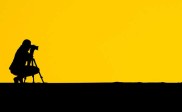Understanding the UV Filter
UV (ultraviolet) camera filters are usually part of a photographer’s standard equipment. They are not as costly as other filters, and they have a variety of uses.
A UV Filter Will Block Ultraviolet Light
The primary function of a UV filter is to block ultraviolet light rays from passing through the lens, while still letting other light waves through. UV light is known for creating haziness and a bluish color cast in photographic film, although the more recent film and most modern digital cameras are not as sensitive to the effects of UV light. These filters usually help in achieving clearer shots with hardly any atmospheric haze. Less fogginess means brighter colors and cleaner image details in photographs.

Photo by Mo-Design
A UV Filter Can Protect Your Lens
Most photographers who have UV filters leave them attached to the lens for most of the time because they offer protection as well. As much as we try to prevent any harm from coming to our precious camera gear, accidents can happen and before we know it, our camera may be plummeting to the hard ground. More than one expensive lens has been saved by the UV filter taking the brunt of the impact of the fall.
Although a shattered UV filter may make you feel bad, you would feel much worse if your more expensive camera lens got broken. Some say that a lens hood can offer the same protection, plus it is usually made of plastic and is less expensive than a filter. Still, you might simply want the added lens protection given by a UV filter, with or without a lens hood.

Photo by pointnshoot
Use the Right UV Filter Size
A UV filter is transparent and is screwed on to the front element of a camera lens. SLR and DSLR lenses usually have screw-in threads for filters, while most point-and-shoots do not. However, some bridge cameras are compatible with filter adaptors, and you can still take advantage of the benefits of a UV filter even if you do not own a DSLR. Since the sizes of camera lenses vary in diameter, corresponding filter sizes have been manufactured to fit the various types of lenses. If your UV filter is not the exact size for your lens, you can still attach your lens to a filter adaptor ring, which can support your particular filter size.
Choose a High Quality UV Filter
The cost of a UV filter can depend on the brand, size, and quality. The average price can range from $7 to $20. If possible, purchase the highest quality filter you can afford, preferably a multi-coated UV filter which will lessen the possibility of lens flare and glare caused by strong lighting.

Photo by praesentire
The photo example above compares two kinds of UV filters. On the left is a multi-coated filter and on the right is a single-coated filter, which shows the glare of light.
UV filters without any coating or those that are of poor quality might introduce flares, which can decrease the sharpness and contrast in your shots. Although these uncoated filters usually cost less, the results may also not be as desirable as with the coated types.




Saved My Camera more than once 🙂